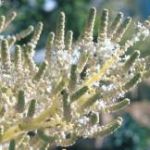| Common Name: |
Watersalie |
| Other Names: |
Ginger Bush, Iboza |
| Botanical Name: |
Tetradenia riparia syn. Iboza riparia |
| Genus: |
Tetradenia |
| Family: |
Lamiaceae |
| Native Location: |
Eastern S Africa to Nambia, Angola, and Ethiopia |
| Cultivation: |
Moist, well-drained soil in sun or partial shade. |
| Propagation: |
By seed sown when ripe; by semi-ripe cuttings in summer. |
| Harvest: |
Leaves are picked during the growing season and used fresh or dried in infusions, or crushed when fresh as an inhalation. |
| Hardiness: |
Min. 10°C (50°F) |
| Parts Used: |
Leaves |
| Properties: |
A bitter, aromatic herb that lowers fevers, relaxes spasms, and is expectorant. |
| Medicinal Uses: |
Internally for colds and flu, bronchitis, stomach upsets, flatulence, mouth ulcers, diarrhea, and fevers (especially malarial). Externally, as an inhalation, for headaches. |
| Economic Uses: |
Dried leaves are good in pot-pourris. |
| Bibliography: |
Encylopedia of Herbs by Deni Brown Copyright ©: 1995, 2001 Dorling Kindersley Limited pp.384-385
|

